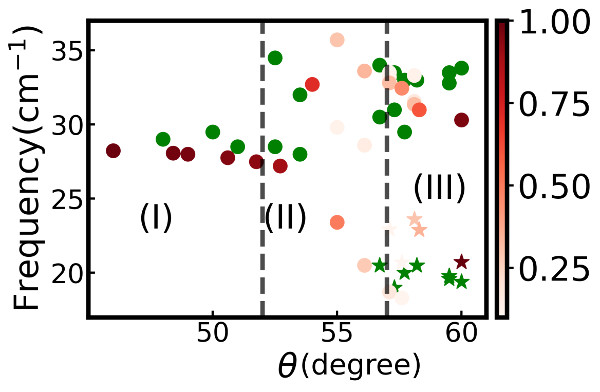
Comparison of the calculated twist-angle dependence of low-frequency vibrational modes and Raman measurements in twisted bilayers of MoSe$_2$. The experimental SMs (LBMs) are denoted by green stars (circles), whereas the computed SMs (LBMs) are denoted by variable red stars (circles).
The tunability of the interlayer coupling by twisting one layer with respect to another layer of two dimensional materials provides a unique way to manipulate the phonons and related properties. We refer to this engineering of phononic properties as twistnonics. We study the effects of twisting on low frequency shear and layer breathing modes in transition metal dichalcogenide bilayer using atomistic classical simulations [1]. We show that these low frequency modes (as well as high frequency Raman-active modes [2,3]) are extremely sensitive to twist and can be used to infer the twist angle. We find unique ultra-soft phason modes [3] (frequency ≤ 1 cm$^{-1}$, comparable to acoustic modes) for any non-zero twist, corresponding to an effective translation of the moir’e lattice by relative displacement of the constituent layers in a non-trivial way. Our studies provide a non-destructive way to characterize the twist angle, the interlayer coupling and establishes the manipulation of phonons in twisted bilayer transition metal dichalcogenides. Fuurthermore, we predict a superlubric to pinning behavior and of the existence of ultrasoft modes in all two-dimensional materials.
References
[1] Kolmogorov-Crespi Potential for Multilayer Transition Metal Dichalcogenides: Capturing Structural Transformations in Moiré Superlattices, Mit H. Naik, Indrajit Maity, Prabal K. Maiti, Manish Jain, The Journal of Physical Chemistry C 123, 9770 (2019).
[2] Evolution of high-frequency Raman modes and their doping dependence in twisted bilayer MoS$_2$, Rahul Debnath, Indrajit Maity, Manish Jain, Arindam Ghosh, Nanoscale (2020).
[3] Phonons in twisted transition-metal dichalcogenide bilayers: Ultrasoft phasons and a transition from a superlubric to a pinned phase, Indrajit Maity, Mit H. Naik, Prabal K. Maiti, H. R. Krishnamurthy, Manish Jain, Physical Review Research 2, 013335 (2020).